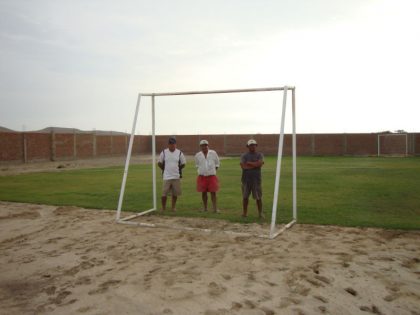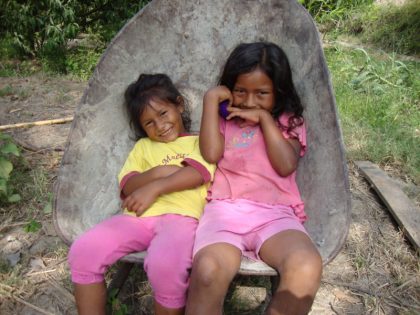 Location
Location
La Isla de Asia, Cañete, Lima, Perú
Community Description
La Isla is a rural community on the coast of southern Peru. It is bordered by the ocean to the west and mountains to the east. The community’s name translates to “The Island”—a name perhaps chosen because although La Isla is six miles inland, it forms a small island of green farmland in the middle of the Peruvian desert.
There are 25 houses in La Isla, home to about 180 adults and children, all farmers. The houses are spaced out by fields of sweet potatoes, corn, squash, peaches, and grapes. The families of La Isla live without electricity, in dirt-floor homes made out of adobe and mud, or in some cases, drywall and wood. On average, about seven people live in each home. They raise chickens, ducks, pigs, and cows for their own consumption, and earn about $10 a day.
Families work from sunup to sundown—by 6 a.m. they are already on their way to the fields, and remain there until around 6 or 6:30 in the evening. “We work,” says one farmer, “until the sun falls.” During the summer, children as young as six years old spend long hours helping their parents in the fields.
 The unpaved roads are so inaccessible that no public transportation passes through La Isla. The nearest bus stop is a half-hour walk away, where buses pass just once an hour. From there it is a 45-minute ride to the closest market. School is a half-hour walk in the opposite direction, as is the health post.
The unpaved roads are so inaccessible that no public transportation passes through La Isla. The nearest bus stop is a half-hour walk away, where buses pass just once an hour. From there it is a 45-minute ride to the closest market. School is a half-hour walk in the opposite direction, as is the health post.
The people of La Isla have long wanted a place to gather as a community and relax at the end of each week on Sunday, their one day off. Last year, a group of farmers began to lobby their district’s municipal government for an enclosed area with a soccer field, a one-room community center, and a small playground. The government built a large, brick enclosure around a sandy area roughly the size of three soccer fields, planted grass on one end of the field, and donated two goal boxes. The other elements of the project were never fulfilled, and although the farmers will be lobbying the government once more this year, there is no guarantee that the community center or playground will ever be built.
Nevertheless, the families of La Isla have been gathering at the soccer field every Sunday for months. They have organized informal soccer and volleyball games that nearly the entire community attends. “Everyone goes,” says one famer, “from the smallest child to the biggest adult. It is our only day of rest.”
Unfortunately, the soccer field lacks any sort of bathroom facilities, and the people of La Isla have to relieve themselves in the fields outside the brick enclosure. This practice is unsanitary, posing a health risk not only because of the uncovered excrement left in the open fields, but because there are no facilities for them to wash their hands immediately afterward. The risk becomes higher in the summer months, January – April, when the community is filled with flies that come into contact with everything from uncovered excrement to food to people.
 Project Description
Project Description
This project will provide a public bathroom and shower within the brick enclosure containing La Isla’s community soccer field.
The bathroom will consist of two rooms—one for men and one for women—and the shower will be designed unisex, with one showerhead. The three rooms will be built side by side against the wall of the brick enclosure. They will have cement floors, brick walls, and a cement ceiling enforced with rebar. The water source will be an existing water tank that is located on a platform where two of the walls meet.
The bathrooms will have flush toilets connected to the water tank above and a pit below. The pit will be 1.5 by 3 meters, lined with burned brick to prevent the interior of the hole from eroding over time. The pit will be covered by a cement slab enforced with rebar, nearly 2 meters wide. It will be located just outside the brick enclosure.
The farmers of La Isla who originally lobbied for a soccer field and playground are part of a community organization called Club Union Isla. Club Union Isla is comprised of about 20 farmers, all male, who live in La Isla.
The farmers of this organization will build the bathroom and shower by dividing into teams of three and rotating the days in which they work on the project. Each team will work on the project one day out of the week, enabling them to contribute to the project without missing more work than they can afford.
The money for this project will be used to purchase bricks for the bathroom walls, cement for the floors and ceiling, rebar to enforce the cement, burned bricks to line the hole, drywall for the doors, and two flush toilets.
Club Union Isla will be donating one sink that will be connected to the water tank, enabling community members to wash their hands after they have used the bathroom. (The sink is old but perfectly functional.)
The remaining supplies will also be provided by community members through Club Union Isla (door hinges, a shower head, a 4-inch sewage tube, a shower knob, five 90-degree connections, a quarter-kilo of PVC glue, and two four-inch Ts).
Project Impact
About 180 people will benefit from this project, consisting of 60 children and 120 adults.
Peace Corps Volunteer Directing Project
Olivia Bevacqua
Comments
This is an important project that will directly benefit every member of this underserved community. It is a modest project, utilizing existing materials and building on local participation for its implementation. It will immediately improve the health and well-being of the villagers.
Dollar Amount of Project
$500.00
Donations Collected to Date
$500.00
Dollar Amount Needed
$0.00 – This project has been fully funded, through the generosity of The Soneva SLOW LIFE Trust as a part of their Clean Water Projects initiative.
We encourage others to continue to donate using the Donate button below, and we will notify Peace Corps Volunteer Olivia Bevacqua of your donation. Additional funds will be used to fund the next project by Olivia and/or those other PCVs in the country of service.
This project has been finished. To read about the conclusion of the project, CLICK HERE.